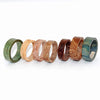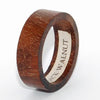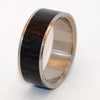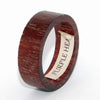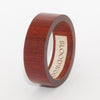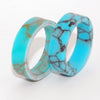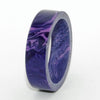About Our Inlay Materials
While we are always on the hunt for more and more inlay materials for our titanium rings, below are some of our most popular.
Hardwood
From the exotic to the everyday, each hardwood inlay is wondrous and inspiring, unique to your very ring. All of the wood we use is ultra stabilized under a patented high pressure process and impregnated with acrylics, making it impermeable to water and incredibly resistant to scratches. If you do not see a particular wood below, just ask!
|
Cherry
Prunus serotina. Cherry is found throughout the US and Canada. A smooth, durable wood with uniform grain, it is yellowish pink to rich reddish brown in color. |
Tulip
Dalbergia decipularis. Found on the Eastern side of the US and in some parts of China, Tulip wood is light brown with a prominent rose pink vertical grain. A light, but strong hardwood. |
Wenge
Millettia laurentii. Native to the Congo and Gabon, Wenge is a dense hardwood deep brown in color with a dark, vertical grain that stretches at points like a tiger's stripes. |
|
California Buckeye
Aesculus Californica. Native to California's Central Coast, California Buckeye is creamy yellow-white to gray-blue and black. Extremely durable and filled with interesting burl. |
African Black
Dalbergia melanoxylon. With its impressive strength and durability, African Black wood is often found in many woodwind instruments. Ranging in color from dark brown to black, it has an average specific gravity of 1.29, meaning that this is a wood that sinks! |
Olive
Olea europaea. Native to the Mediterranean Sea region, Olive wood has long had a sacred aura because of its mention in both the Bible and Qur'an. Dark brown Streaks contrast attractively within the yellowish-brown heartwood. |
|
Ancient Kauri
Agathis australis. Long-preserved beneath the peat swamps of New Zealand's North Island, Ancient Kauri wood is carbon dated at more than 45,000 years old, making it the oldest workable wood in a the world and a valued heirloom. Light yellow to medium brown in color, Kauri's wood grain takes on an iridescent quality when sanded and finished. |
Box Elder
Acer negundo. Lots of wavy grain and burl throughout. Considered part of the Maple family, Box Elder is commonly found in Central and Eastern North America. The fabulous thing about Box Elder is that it takes brilliantly to dye. As part of the stabilization process, we are able to flush it through with different dyes. Red, Burgundy, Clear, Golden, Green, Blue and Black are the most popular choices. |
Rosewood
Dalbergia. Rosewood is a common name for many different types of wood. Reddish brown to dark brown with a deep, symmetrical grain, Rosewood is heavy and strong. |
|
Red and Black Palm
Cocos nucifera. Red Palm wood and Black Palm wood are both native to Myanmar and feature a quilled pattern with light yellow highlights. |
Maple
Acer. There are 129 species of Maple, occurring in Asia, Europe, North Africa, and North America. Like Box Elder, Maple also takes very well to dye. In the picture above from left to right is Green Maple Burl, Clear Maple, Light Maple, Birds Eye Maple, Dark Maple, Sugar Maple and Blue Maple Burl. |
Light and Dark Cocobolo
Dalbergia retusa. A tropical hardwood, Cocobolo is native to Central America and appears orange to dark reddish-brown, with a figuring of darker irregular traces weaving throughout. High in natural oil content, Cocobolo makes a rich and glowing inlay. |
|
Gabon Ebony
Diospyros crassiflora. Often called "the blackest wood in the world", Gabon Ebony is a hard, dense and heavy wood that hails from Africa. It is favored among musical instrument makers with its ability to take on a high polish. |
Black Walnut
Fraxinus nigra. Black Ash Burl is native to Eastern Canada and the North Eastern US. Light yellow to brown with a smokey burl, Black Ash is a popular wood also used for making guitars, basses and baskets. |
Thuya Burl
Tetraclinis articulata - Thuya is a conifer native to Morocco. The name means "sacrifice" in Greek, because the oil distilled from this tree was used as incense during religious ceremonies. The brownish-orange wood is full of "dark eyes" and other interesting burl. |
|
Black Ash Burl
Acer negundo. Considered part of the Maple family, Box Elder is commonly found in Central and Eastern North America. A clear veneer showcases its natural color, with pink to gray burl. |
Moluccas Macassar
Diospyros celebica. Native to India, Indonesia and the Philippines, Macassar Ebony is a strong jet-black hardwood with a distinctive reddish dark brown streaking pattern. Very popular with fine furniture makers during the Art Deco period. |
Amboyna Burl
Pterocarpus indicus)A rare, exotic hardwood native to Southeast Asia, Amboyna Burl is reddish brown with numerous captivating swirls of golden yellow to deep red. Takes on a reflective glow when finished. One of the world's most popular and sought after burl. |
|
Ukranian Bog Oak
Morta. Ukrainian bog oak has been carbon dated and is approximately 5500-5600 years old. The deep black color is a result of what the trees go through from being submerged in bogs for many thousands of years with the acidic waters and lack of oxygen. |
Purple Heart
Leguminosae. Native to Central and South America, Purple heart wood is a bright, striking purple when freshly cut, darkening to a deeper purple with age. The wood has a straight grain and medium to high luster.
|
Bloodwood
Brosimum paraense. Native to South America, Bloodwood is a rich strawberry red color and takes a high, lustrous finish. |
|
Hawaiian Koa
Acacia koa. The largest endemic tree native to Hawaii, Koa was historically the material of choice for hand carved canoes. Its colors range from light brown to deep red-brown hues. With a weight and strength is similar to Black Walnut, it takes on an exceptionally rich and deeply reflective glow when finished. |
Salvaged Redwood and Blue Redwood Lace Burl
Redwoods are the tallest living trees that have ever been on planet earth! Coastal Redwoods (Sequoia sempervirens) are the tallest trees, but their cousins, the giant Sequoia (Sequoia gigantium) take the record for the largest living tree in the World. In the mid 1800's logging operations commenced in the forests where these beautiful trees grow, leaving behind a path of stumps and logs that were deemed unusable. Today, stumps and logs less than 16 ft. long are being extracted from these areas. Most of this salvaged wood still produces solid wood that has been aged and slowly dried over a hundred or more years. |
Our Redwood is all salvaged. Redwood is suitable for large tables, bar tops, mantles, cabinets, Guitar tops, and turnings. Figured boards are sometimes available with flame, fiddleback, or burl eyes which can produce beautiful bass or electric guitars or other high end projects. |
M3 Metal - Mokume Gane
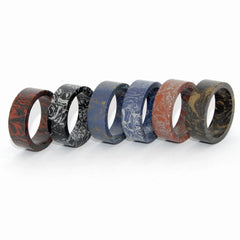 M3 is short for Macro Molecular Metal and is made up of metal that has been deconstructed to the macro molecular level, re-alloyed and then reconstructed, creating a completely new metal composite material. The Mokume line of M3 Metal is a modern interpretation of an Ancient Japanese method, melding metals to create organic patterns of marbled grain and burl. Originally created in 17th century Japan as adornment for samurai sword handles and sheaths, Mokume Gane reflects the finest hour of craftsmanship - reproducing the intrinsic beauty of mother nature herself.
M3 is short for Macro Molecular Metal and is made up of metal that has been deconstructed to the macro molecular level, re-alloyed and then reconstructed, creating a completely new metal composite material. The Mokume line of M3 Metal is a modern interpretation of an Ancient Japanese method, melding metals to create organic patterns of marbled grain and burl. Originally created in 17th century Japan as adornment for samurai sword handles and sheaths, Mokume Gane reflects the finest hour of craftsmanship - reproducing the intrinsic beauty of mother nature herself.
From left to right in picture is: Black and Red, Black and Silver, Blue and Bronze, Blue and Silver, Red and Silver, Black and Gold.
Horn and Antler Inlays
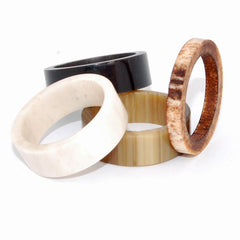 Counter Clockwise from top - Water Buffalo Horn, Deer Antler, Cattlehorn, Moose Antler
Counter Clockwise from top - Water Buffalo Horn, Deer Antler, Cattlehorn, Moose Antler
Asian Water Buffalo Horn is an extremely durable material traditionally used for knife handles and gun grips. Jet-black in color, Water Buffalo horn shines against a titanium backdrop
Our Sambar Stag Deer Antler is sourced from India. All of the horn harvested has been naturally shed by the deer. The Antler ranges in color from bone-white to creamy-yellow.
Cattle horn has Creamy yellow to honey tones with a subtle dusky shadow.
Moose Antler ranges in whiter colors with brown undertones.
Opalescent Resin Inlays
Cast polyester is 100% waterproof and extremely durable. Our opalescent inlays feature several different formulas, including Pearl, Sparkle, Marble and Transparent.
|
From left to right - Black Marbled, Jet Black, Blue Marbled, Plain Turquoise, Blue Vintage, Cobalt Blue Sparkle |
From Left to right - Green Pearl, Vintage Green, Antique Green, Green Marbled |
From Left to right - Burgundy Marbled, Purple Marbled, Pink Marbled, Red Marbled, Ruby Pearl, Bronze Marbled, Copper Marbled, White Pearl, Gray Pearl |
Concrete Inlays
 Concrete is both modern and timeless, with unlimited possibilities in style, texture and color. Super durable, our concrete inlays are made to last a lifetime and beyond. The great thing about Concrete is that we can include personal material as aggregate. Have some sand from the beach you first kissed on? Send us a tablespoon of it! How about a rock you found on a walk together or gravel from your driveway. Send it our way!
Concrete is both modern and timeless, with unlimited possibilities in style, texture and color. Super durable, our concrete inlays are made to last a lifetime and beyond. The great thing about Concrete is that we can include personal material as aggregate. Have some sand from the beach you first kissed on? Send us a tablespoon of it! How about a rock you found on a walk together or gravel from your driveway. Send it our way!
Stone Inlays
|
Black Webbed Asian Jade and |
Gold Webbed Tibetan Turquoise and |
Larimar |
|
Charoite |
Pyrite |
Sodalite |
|
Spotted Azurite Malachite |
Banded Azurite Malachite |
Black Onyx and Wild Horse Jasper |
|
Honey Jasper |
Gaspeite |
Banded Malachite |
|
Webbed Malachite |
Tiger Eye |
Gaspeite Turquoise Jasper Composite |










